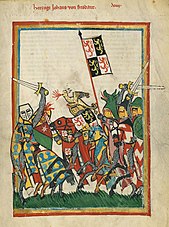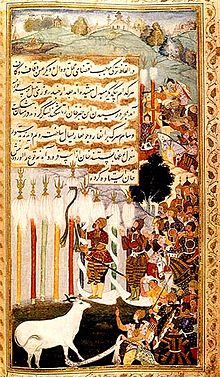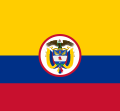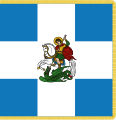
A war ensign, also known as a military flag, battle flag, or standard, is a variant of a national flag for use by a country's military forces when on land. The nautical equivalent is a naval ensign. Under the strictest sense of the term, few countries today currently have distinct war flags, most using a flag design that is also the state flag or general national flag for this purpose.
History
Further information: Oriflamme, Heraldic flag, Banner, Vexilloid, Field sign, and Royal StandardSound trumpets! Let our bloody colours wave! And either victory, or else a grave.
— Edward, Prince of Wales, in Henry VI, Part 3, Act II, Scene II
Field signs were used in early warfare at least since the Bronze Age. The word standard itself is from an Old Frankish term for a field sign (not necessarily a flag).

The use of flags as field signs apparently emerges in Asia, during the Iron Age, possibly in either China or India. in Achaemenid Persia, each army division had its own standard, and "all officers had banners over their tents". Early field signs that include, but are not limited to a flag, are also called vexilloid or "flag-like", for example the Roman Eagle standard or the dragon standard of the Sarmatians. The Roman Vexillum itself is also "flag-like" in the sense that it was suspended from a horizontal crossbar as opposed to a simple flagpole.
Use of simple flags as military ensigns becomes common during the medieval period, developing in parallel with heraldry as a complement to the heraldic device shown on shields. The maritime flag also develops in the medieval period. The medieval Japanese Sashimono carried by foot-soldiers are a parallel development.
Some medieval free cities or communes did not have coats of arms, and used war flags that were not derived from a coat of arms. Thus, the city of Lucerne used a blue-white flag as a field sign from the mid 13th century, without deriving it from a heraldic shield design.
Current war flags
Used by armed forces only
-
 War flag of Brunei
War flag of Brunei
-
 Canadian Armed Forces ensign
Canadian Armed Forces ensign
-
 War flag of the People's Liberation Army of China
War flag of the People's Liberation Army of China
-
 War flag of the Republic of China Armed Forces
War flag of the Republic of China Armed Forces
-
 War flag of Colombia
War flag of Colombia
-
 War flag of Georgia
War flag of Georgia
-
 Flag of the Iranian Army
Flag of the Iranian Army
-
 War flag of Italy
War flag of Italy
-
 Flag of the Japan Ground Self-Defense Force
Flag of the Japan Ground Self-Defense Force
-
 War flag of the Korean People's Army of North Korea
War flag of the Korean People's Army of North Korea
-
 Flag of the Armed Forces of Moldova
Flag of the Armed Forces of Moldova
-
 Flag of the Armed Forces of Myanmar
Flag of the Armed Forces of Myanmar
-
 Flag of the Armed Forces of Pakistan
Flag of the Armed Forces of Pakistan
-
 War flag of Peru
War flag of Peru
-
 War flag (regimental color) of Portugal
War flag (regimental color) of Portugal
-
 Banner of the Armed Forces of the Russian Federation
Banner of the Armed Forces of the Russian Federation
-
 War flag of the Royal Staff of Saudi Arabian Armed Forces
War flag of the Royal Staff of Saudi Arabian Armed Forces 
-
 Flag of the Armed Forces of Serbia
Flag of the Armed Forces of Serbia
-
 Flag of the Armed Forces of Ukraine
Flag of the Armed Forces of Ukraine
-
 Flag of the Vietnam People's Army
Flag of the Vietnam People's Army
Army (land) use only
-
 Bangladesh Army
Bangladesh Army
-
 British Army non-ceremonial flag
British Army non-ceremonial flag
-
 Bulgaria
Bulgaria
-
 Flag of the People's Liberation Army Ground Force
Flag of the People's Liberation Army Ground Force
-
 War flag of the Republic of China Army
War flag of the Republic of China Army
-
 Flag of the Colombian Army
Flag of the Colombian Army
-
 Georgia Land Forces
Georgia Land Forces
-
 War flag (regimental color) of the Hellenic Army
War flag (regimental color) of the Hellenic Army
-
 War flag of Hungary
War flag of Hungary
-
 Indian Army
Indian Army
-
 Malaysian Army flag
Malaysian Army flag
-
 Myanmar Army flag
Myanmar Army flag
-
 Pakistan Army
Pakistan Army
-
 Polish Land Forces
Polish Land Forces
-
 Russian Ground Forces
Russian Ground Forces
-
 Saudi Arabian Army
Saudi Arabian Army 
-
 Korean People's Army Ground Force
Korean People's Army Ground Force
-
 Republic of Korea Army
Republic of Korea Army
-
 Royal Thai Army
Royal Thai Army
-
 Flag of Turkish Land Forces Command
Flag of Turkish Land Forces Command
-
 Ukrainian army
Ukrainian army
-
 United States Army
United States Army
-
 Flag of the Vietnam People's Army
Flag of the Vietnam People's Army
War flags that are also naval ensigns
-
 State, war flag, and state ensign of Austria
State, war flag, and state ensign of Austria
-
 State, war flag, and state ensign of Denmark
State, war flag, and state ensign of Denmark 
-
 State, war flag, and state ensign of El Salvador
State, war flag, and state ensign of El Salvador 
-
 War ensign of Finland
War ensign of Finland
-
 State, war flag, and state ensign of Germany
State, war flag, and state ensign of Germany 
-
 State and state/naval ensign of Iceland
State and state/naval ensign of Iceland 
-
 Naval Ensign of Japan
Naval Ensign of Japan
-
 State/war flag and state/naval ensign of Norway
State/war flag and state/naval ensign of Norway 
-
 Flag of the Philippines at war
Flag of the Philippines at war 
-
 Flag of Saudi Arabian naval bases
Flag of Saudi Arabian naval bases 
-
 War ensign of Sweden
War ensign of Sweden
-
 State, war flag, state, and naval ensign of Venezuela
State, war flag, state, and naval ensign of Venezuela 
Former war flags
-
 Flag of Bangladesh during Bangladesh Liberation War
Flag of Bangladesh during Bangladesh Liberation War
-
 The original Eureka Flag specimen, rebel warflag at the 1854 Battle of Eureka Stockade
The original Eureka Flag specimen, rebel warflag at the 1854 Battle of Eureka Stockade
-
 Battle flag of the Confederate States (1861–1865)
Battle flag of the Confederate States (1861–1865)
-
 Cross of Burgundy Flag, Spain (1506–1843)
Cross of Burgundy Flag, Spain (1506–1843)
-
 War flag of the Imperial Japanese Army (1868–1945)
War flag of the Imperial Japanese Army (1868–1945)
-
 War flag of the People's Republic of Congo (1970–1991)
War flag of the People's Republic of Congo (1970–1991)
-
 The "Gadsden flag", used by some Continental forces during the American Revolutionary War (1775–1783)
The "Gadsden flag", used by some Continental forces during the American Revolutionary War (1775–1783)
-
 Battle flag of the United Irishmen, used at the Battle of Arklow
Battle flag of the United Irishmen, used at the Battle of Arklow
-
 War flag of East Germany (1960–1990)
War flag of East Germany (1960–1990)
-
 War flag of the German Wehrmacht (1938–1945)
War flag of the German Wehrmacht (1938–1945)
-
 War flag of the Chetniks (1903–1946)
War flag of the Chetniks (1903–1946)
-
 War flag and ensign of Iran (1925–1979), between 1910 and 1925 the Kiani Crown was used instead of Pahlavi Crown
War flag and ensign of Iran (1925–1979), between 1910 and 1925 the Kiani Crown was used instead of Pahlavi Crown
-
 War flag of the Italian Social Republic (1943–1945)
War flag of the Italian Social Republic (1943–1945)
-
 War flag of the Ottoman Empire (1912)
War flag of the Ottoman Empire (1912)
-
 War flag of Prussia (1816)
War flag of Prussia (1816)
-
 War flag of the German Empire (1903–1919)
War flag of the German Empire (1903–1919)
-
 War flag of the Roman Republic of 1849
War flag of the Roman Republic of 1849
-
 Flag of the Red Army and Soviet Armed Forces (Unofficial)
Flag of the Red Army and Soviet Armed Forces (Unofficial)
-
 Royal Siamese Army in Haw wars (1885–1890)
Royal Siamese Army in Haw wars (1885–1890)
-
 War flag of Mughals (1526–1857)
War flag of Mughals (1526–1857)
-
 United States Cavalry guidon.
United States Cavalry guidon.
-
 War flag of the Royal Italian Army
War flag of the Royal Italian Army
-
 War ensign of the Slovak Republic (client state of Nazi Germany 1939–1945)
War ensign of the Slovak Republic (client state of Nazi Germany 1939–1945)
-
 War flag of the Independent State of Croatia (client state of Nazi Germany 1941–1945)
War flag of the Independent State of Croatia (client state of Nazi Germany 1941–1945)
-
 War flag of the Royal Hungarian Army (1939–1945)
War flag of the Royal Hungarian Army (1939–1945)
-
 Royal Yugoslav Army
Royal Yugoslav Army
-
 Royal Yugoslav Navy
Royal Yugoslav Navy
-
 Yugoslav Ground Forces
Yugoslav Ground Forces
-
 Yugoslav Navy
Yugoslav Navy
-
 Federal Republic of Yugoslavia Armed Forces
Federal Republic of Yugoslavia Armed Forces
-
 Federal Republic of Yugoslavia Navy
Federal Republic of Yugoslavia Navy
-
 War flag of Zaire
War flag of Zaire
See also
References
- "standard". Oxford English Dictionary (Online ed.). Oxford University Press. (Subscription or participating institution membership required.)
- flag. (2008). Encyclopædia Britannica. Chicago: Encyclopædia Britannica.
- E. Pottier, Douris, London, 1909, p. 105 fig. 20, Plate XXV.b
- "India before British Rule". www.crwflags.com. Archived from the original on 2021-01-16. Retrieved 2021-01-10.
Further reading
- Wise, Terence (1978) Military flags of the world, in color. New York: Arco Publishing. 184p. ISBN 0668044721. War flags of 1618–1900.